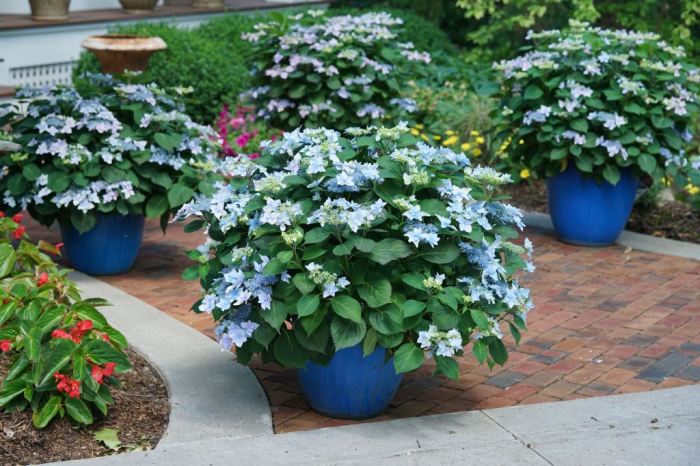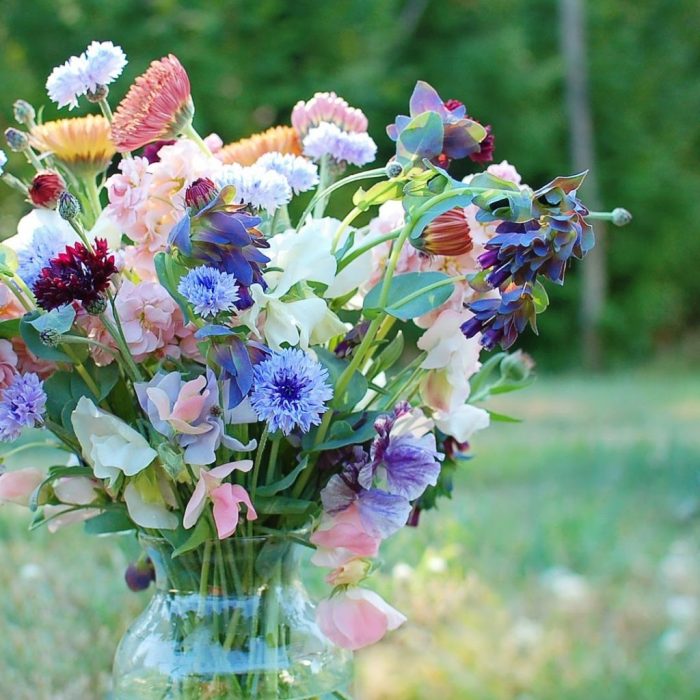Hydrangea Potting Mix Requirements
Hydrangea plant care potted – Providing hydrangeas with the correct potting mix is crucial for their health and vibrant flowering. The ideal mix balances excellent drainage to prevent root rot with sufficient moisture retention to keep the plant hydrated. This delicate balance ensures the roots receive adequate oxygen while maintaining consistent access to water and nutrients.
A well-draining potting mix prevents waterlogging, a common cause of root rot in hydrangeas. Simultaneously, the mix must retain enough moisture to supply the plant’s water requirements, particularly during periods of hot, dry weather. The ideal mix achieves this through a combination of organic matter for moisture retention and inorganic components for improved drainage.
Commercial Potting Mixes for Hydrangeas
Several commercially available potting mixes are suitable for growing hydrangeas. The best choice depends on factors such as cost, accessibility, and the specific composition of the mix. The following table compares four popular options, highlighting their drainage properties and approximate costs. Note that prices can vary depending on retailer and location.
| Brand | Composition | Drainage Properties | Approximate Cost (per unit) |
|---|---|---|---|
| FoxFarm Ocean Forest Potting Soil | Potting soil, peat moss, composted fir bark, earthworm castings | Good drainage, retains some moisture | $20-$25 |
| Miracle-Gro Performance Organics All Purpose Container Mix | Peat moss, coco coir, perlite, vermiculite, compost | Good drainage, retains moisture | $15-$20 |
| Espoma Organic Potting Mix | Peat moss, composted bark, perlite | Good drainage, retains moisture | $18-$22 |
| Black Gold All-Purpose Potting Mix | Peat moss, composted bark, perlite, vermiculite | Excellent drainage, retains moisture | $16-$21 |
Soil pH and Hydrangea Growth
Soil pH plays a significant role in hydrangea flower color and overall plant health. Hydrangeas generally prefer slightly acidic soil conditions (pH 5.5-6.5) for optimal growth and vibrant blooms. In more alkaline soils (higher pH), the flowers may exhibit less intense color, or even appear green or pale. To adjust the pH of a potting mix, elemental sulfur can be incorporated to lower the pH, while ground limestone can be added to raise it.
Always follow the instructions on the packaging of any pH adjusting product carefully. Regular soil testing is recommended to monitor pH levels and make necessary adjustments.
Watering Potted Hydrangeas
Proper watering is crucial for the health and vibrant flowering of potted hydrangeas. Hydrangeas prefer consistently moist, but not soggy, soil. Overwatering or underwatering can lead to significant problems, impacting bloom production and overall plant vigor. The ideal watering schedule depends on several interacting factors.Maintaining adequate soil moisture is vital for optimal hydrangea growth. The frequency of watering depends on several factors, including the climate, the size of the pot, and the maturity of the plant.
Larger pots retain moisture longer than smaller ones, while mature plants, with more extensive root systems, generally require more water than younger plants. Hot, dry climates necessitate more frequent watering than cooler, more humid environments. Careful observation of the soil moisture is key to establishing an appropriate watering regime.
Watering Schedule Considerations
A general guideline suggests watering when the top inch or two of soil feels dry to the touch. However, this is a subjective measure and should be adjusted based on the specific conditions. In hot, sunny locations, daily watering might be necessary for smaller pots, whereas larger pots in shadier, cooler areas may only require watering every few days.
During periods of extended drought or intense heat, more frequent watering is essential. Conversely, during cooler, wetter periods, watering frequency should be reduced to prevent root rot. Regular monitoring of soil moisture, using a finger or moisture meter, is recommended to avoid both underwatering and overwatering.
Successful hydrangea plant care in pots hinges on providing well-draining soil that retains moisture. The ideal soil composition differs from that needed for other plants; for instance, the coarse, well-draining mix suitable for a snake plant, as detailed on this informative site about snake plant potting soil , would be too fast-draining for hydrangeas. Therefore, amending potting mix for hydrangeas with organic matter is crucial for optimal growth and bloom.
Signs of Underwatered and Overwatered Potted Hydrangeas
Recognizing the symptoms of both underwatering and overwatering is essential for maintaining healthy hydrangeas. Early detection allows for corrective action, preventing irreparable damage.
- Underwatering: Wilting leaves, dry and brittle soil, stunted growth, leaf scorch (brown, crispy leaf edges), and reduced flowering are common indicators of underwatering. The plant may appear generally stressed and lethargic.
- Overwatering: Yellowing leaves, soggy soil, root rot (indicated by a foul odor emanating from the soil), and wilting leaves (despite moist soil) are characteristic symptoms of overwatering. The plant may exhibit poor drainage and develop fungal diseases.
Watering Methods and Their Effects
Two primary watering methods exist: top watering and bottom watering. Each possesses advantages and disadvantages.
- Top Watering: This involves directly applying water to the surface of the soil. It is the most common method, convenient and readily accessible. However, top watering can lead to soil compaction if not done carefully, potentially hindering proper drainage and aeration. It also risks wetting the foliage, which can encourage fungal diseases.
- Bottom Watering: This method involves placing the pot in a tray of water, allowing the soil to absorb moisture from the bottom up. This approach ensures even hydration, reduces the risk of soil compaction, and minimizes leaf wetting. However, bottom watering is less convenient and requires monitoring to prevent overwatering. It is also less effective for pots with poor drainage holes.
Pruning and Maintenance of Potted Hydrangeas

Proper pruning and maintenance are crucial for the health and continued blooming of potted hydrangeas. These techniques ensure the plant remains vigorous, aesthetically pleasing, and produces abundant flowers. Different pruning methods cater to specific needs, from removing spent blooms to shaping the overall plant structure.
Deadheading Hydrangeas
Regular deadheading, the removal of spent flowers, is essential for promoting continuous flowering in hydrangeas. By removing faded blooms, the plant redirects its energy towards producing new flower buds instead of expending resources on seed production. This results in a longer flowering period and a more attractive plant. Deadheading should be performed consistently throughout the blooming season. Simply pinch or cut the flower head back to the first set of healthy leaves below the spent bloom.
Avoid cutting into the woody stems.
Shaping Hydrangeas
Pruning for shaping is typically done in late winter or early spring, before new growth begins. This involves removing any dead, damaged, or crossing branches to improve air circulation and maintain a desirable plant shape. For mophead and lacecap hydrangeas, minimal pruning is usually sufficient, focusing on removing only dead or diseased stems. However, paniculata hydrangeas, which bloom on new wood, can tolerate more aggressive pruning to control size and shape.
This pruning should be done by cutting back to a pair of outward-facing buds.
Repotting Potted Hydrangeas
Repotting is necessary when the hydrangea becomes root-bound, indicated by roots circling the pot or emerging from the drainage holes. This typically occurs every 2-3 years, depending on the plant’s growth rate and pot size. Choose a pot only slightly larger than the previous one, usually about 2-3 inches in diameter larger. A significantly larger pot can lead to excessive moisture retention and root rot.
Use a well-draining potting mix specifically formulated for hydrangeas, or a mix of peat moss, perlite, and compost. Gently remove the plant from its existing pot, loosen any circling roots, and place it in the new pot with fresh potting mix, ensuring the crown of the plant is at the same level as before. Water thoroughly after repotting.
Common Pests and Diseases Affecting Potted Hydrangeas

Potted hydrangeas, while beautiful additions to any garden or patio, are susceptible to a range of pests and diseases. Early detection and appropriate management are crucial for maintaining the health and vibrancy of these plants. Understanding the common culprits and implementing preventative and treatment strategies is essential for successful hydrangea cultivation.
Pest and Disease Symptoms
Identifying pests and diseases early is critical for effective management. Accurate diagnosis allows for targeted treatment, preventing widespread damage and promoting plant recovery. The following list details common symptoms associated with various pests and diseases.
- Aphids: These small, soft-bodied insects cluster on stems and leaves, causing leaf curling, yellowing, and stunted growth. Honeydew, a sticky substance excreted by aphids, may also be present, attracting ants and promoting sooty mold growth.
- Spider mites: These tiny arachnids feed on plant sap, resulting in stippling (small, pale spots) on leaves, followed by leaf discoloration and webbing, particularly on the undersides of leaves. Infestations can cause significant leaf damage and plant stress.
- Powdery mildew: This fungal disease manifests as a white, powdery coating on leaves and stems, hindering photosynthesis and potentially leading to leaf distortion and premature leaf drop. High humidity and poor air circulation contribute to its development.
- Downy mildew: Unlike powdery mildew, downy mildew appears as fuzzy, grayish-purple patches on the undersides of leaves, with corresponding yellowing or browning on the upper surfaces. It thrives in cool, humid conditions.
- Leaf spot: Various fungal pathogens can cause leaf spot, characterized by brown or black spots on leaves, sometimes with yellow halos surrounding the lesions. Severe infestations can lead to defoliation.
- Root rot: Caused by various soilborne fungi, root rot manifests as wilting, yellowing leaves, and stunted growth, despite adequate watering. Affected roots appear brown and mushy.
Preventative Measures for Pest and Disease Management
Proactive measures significantly reduce the risk of pest and disease infestations. These preventative strategies contribute to the overall health and resilience of potted hydrangeas.
- Proper watering and fertilization: Maintaining appropriate soil moisture and providing balanced fertilization strengthens plants, making them less susceptible to pests and diseases. Avoid overwatering, which promotes root rot.
- Good air circulation: Ensure adequate spacing between plants and provide sufficient air circulation to minimize humidity, thereby reducing the risk of fungal diseases like powdery mildew and downy mildew. Avoid overcrowding.
- Sanitation: Regularly remove and dispose of fallen leaves and debris to eliminate potential sources of pests and diseases. Clean pruning tools before and after use to prevent the spread of pathogens.
- Disease-resistant cultivars: Selecting disease-resistant hydrangea varieties can significantly reduce the likelihood of pest and disease problems. Consult local nurseries for recommendations suitable for your region.
Treatment Methods for Pest and Disease Infestations, Hydrangea plant care potted
Effective treatment depends on accurate identification of the pest or disease. Both organic and chemical methods are available, with choices dependent on severity and personal preference.
- Organic methods: For mild infestations, organic methods often suffice. These include insecticidal soaps for aphids and spider mites, neem oil for various pests, and fungicides derived from natural sources like copper or sulfur for fungal diseases. Always follow product instructions carefully.
- Chemical methods: For severe infestations, chemical pesticides and fungicides may be necessary. These should be used as a last resort and strictly according to label instructions, prioritizing safety for humans, pets, and beneficial insects. Choose products specifically formulated for hydrangeas and target the identified pest or disease.
Frequently Asked Questions: Hydrangea Plant Care Potted
Can I grow hydrangeas in containers year-round?
Yes, but you may need to move them indoors or provide extra protection during harsh winter conditions depending on your climate.
How often should I fertilize my potted hydrangeas?
Feed every 2-4 weeks during the growing season (spring and summer) with a balanced, acid-loving fertilizer.
What are the signs of a hydrangea needing repotting?
Roots circling the bottom of the pot, stunted growth, and frequent drying out despite watering are all signs it’s time to repot.
Why aren’t my hydrangeas blooming?
Lack of sunlight, improper soil pH, insufficient nutrients, or incorrect pruning can all hinder blooming. Review each aspect of care.
How do I prevent powdery mildew on my potted hydrangeas?
Ensure good air circulation, avoid overhead watering, and consider using a preventative fungicide.


